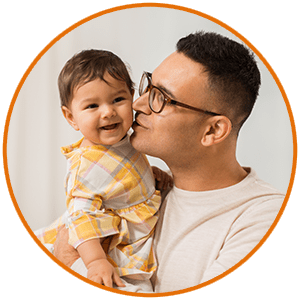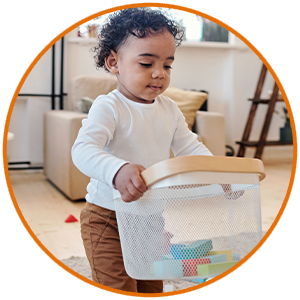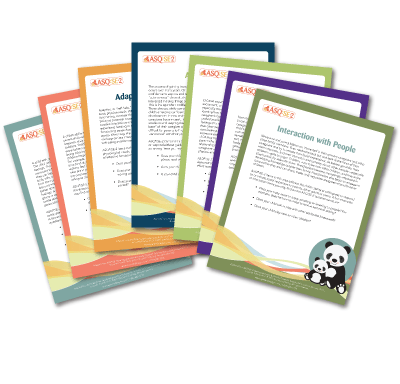7 Areas of Social-Emotional Development: What They Are and How to Support Them

Healthy social-emotional development has always been a crucial success factor for young children, but in the COVID-19 era and beyond, supporting early social-emotional skills will be more important than ever. ASQ®:SE-2 effectively screens 7 key social-emotional areas children will need for school and for the rest of their lives: self-regulation, compliance, adaptive functioning, autonomy, affect, social-communication, and interaction with people. In this article, we’ll take a look at each of these important areas and share some practical ways that parents and caregivers can support development at home between screenings.
Self-Regulation
 Managing emotions is one of the most crucial social-emotional skills a child will learn, and one that may require the most support from parents, families, and caregivers. Trouble falling asleep, extended tantrums, and difficulty moving between activities are all signs that a young child might need more focused support to strengthen their self-regulation skills. Share these tips with the primary caregivers in your program so they can help their child follow directions, soothe themselves when they’re having big feelings, and calm down after exciting events:
Managing emotions is one of the most crucial social-emotional skills a child will learn, and one that may require the most support from parents, families, and caregivers. Trouble falling asleep, extended tantrums, and difficulty moving between activities are all signs that a young child might need more focused support to strengthen their self-regulation skills. Share these tips with the primary caregivers in your program so they can help their child follow directions, soothe themselves when they’re having big feelings, and calm down after exciting events:
- Establish a consistent home routine (eating, sleeping, diapering, bath time, playtime, etc.) for your baby, making sure to explain to them what you’re doing and what will come next. You could say something like, “We’re having fun playing with blocks, but soon we’re going to go upstairs for a bath.” Knowing what to expect will help your baby feel more safe and secure and lead to smoother transitions between activities. Age range: 12 months
- Keep in mind that calm can be contagious. When your child has a temper tantrum, try to stay as calm as possible and speak in very placid tones. See if your child can calm down after getting these cues from you. Age range: 2–3 years
- Recognize and name feelings. Help your child recognize, name, and talk about their emotions. At the library, read a book about anger with your child and talk to them about how their body feels when they’re angry. Discuss safe, healthy ways they can process their anger (focused breathing, baby yoga, etc.). Age range: 3–4 years
- Provide a safe space for feelings. The next time your child has an argument with a friend or sibling, urge them to express their feelings in words, and remind them that they can always come to you when they’re upset or need to talk. Age range: 5 years
Compliance

Establishing consistent routines, rules, and expectations for children also helps boost development in another key social-emotional area: compliance. Children are generally more cooperative if requests are made in developmentally appropriate language, and they’re given positive reinforcement when they do what’s asked of them. Here are some quick tips that can help promote more responsive (and less stressful!) caregiver–child relationships:
- Give them a small job to do. Two years of age is when toddlers start understanding more complex requests and can be given small tasks. After playtime, pull out a storage container or box and ask your child to help you clean up. Try making a game of it by seeing who can put away the most toys. Make sure to enthusiastically praise your child when you’re finished! Age range: 2 years
- Play games that teach compliance skills. Young children often learn best through play, so play games with them that emphasize the importance of taking turns, like Hopscotch and Follow the Leader. Age range: 3–4 years
- Keep your rules short and simple. At 3 to 4 years of age, children are starting to develop the ability to follow rules more consistently, but they’ll still need regular reminders about your family’s behavioral expectations. You’ll have a better chance of getting your child to follow rules if you keep directives short, simple, and consistent. Age range: 3–4 years
- Make sure they get plenty of rest: A young child’s capacity for being cooperative decreases significantly when they’re tired or overstimulated. Provide them with ample opportunity for rest and quiet time, and enforce a predictable bedtime at night. Age range: 0–5 years
Adaptive Functioning
 Adaptive functioning skills include anything a young child does to meet their basic needs throughout the day, including self-care and grooming, going to bed when tired, getting dressed, and eating. Use the following strategies to nurture a child’s ability to navigate the requirements of daily life:
Adaptive functioning skills include anything a young child does to meet their basic needs throughout the day, including self-care and grooming, going to bed when tired, getting dressed, and eating. Use the following strategies to nurture a child’s ability to navigate the requirements of daily life:
- Begin encouraging your child’s self-reliance by putting a child-safe stepstool near the sink so they can wash their hands and brush their teeth.* Let them pick out their clothes for the day and see if they can get dressed on their own. Age range: 2 years
- Talk to your child about safety hazards. Speak with your child about common household dangers like electrical outlets and equipment, kitchen appliances, and stovetops. It’s also important to talk to your child about potential dangers outside the home, like street crossings and talking to strangers.* Be sure to use gentle, age-appropriate language so your child doesn’t become agitated or frightened. Age range: 3–4 years
- Let them decide. Build your child’s confidence and sense of agency by providing them with plenty of opportunities to make choices throughout the day. Ask them, “Do you want to go to the park or play at home?” Age range: 2–5 years
Autonomy
 Every early childhood educator and caregiver has heard a toddler yell something like, “Me do it!” As occasionally frustrating as those outbursts can be, they’re positive indicators that a child feels safe and secure enough to explore their growing autonomy and sense of self. These suggestions will help parents and caregivers continue to support their child’s emerging independence:
Every early childhood educator and caregiver has heard a toddler yell something like, “Me do it!” As occasionally frustrating as those outbursts can be, they’re positive indicators that a child feels safe and secure enough to explore their growing autonomy and sense of self. These suggestions will help parents and caregivers continue to support their child’s emerging independence:
- Ask them for some help. Ask your child to “help” you make lunch or dinner. Designate a special drawer or cupboard and fill it with safe kitchen items like measuring cups and spoons that your little helper can sort through and proudly display to you. Say things like, “Thanks for doing that! You’re a great helper!” Age range: 12 months
- Go exploring. Whether it’s weeds poking through pavement or a squirrel dashing around a tree, there are thousands of fascinating new things for toddlers to experience. Let your child explore the outside world (with you nearby), and take the time to talk with them about each new discovery they make. Age range 2–5 years
- Provide opportunities for responsibility. Start giving your child light responsibilities and little jobs around the house. You could ask them to dust with a damp cloth or clean up their room, and let them do some things on their own like fixing an afternoon snack. Always make sure you offer praise for a job well done! Age range 3–5 years
Affect
 The human face is a map, and children learn to read it when they’re newborns, mimicking the facial expressions of caregivers and receiving their first introduction to the dazzling kaleidoscope of human emotions. As a child’s development continues, they start to recognize and name their own feelings and respond with sensitivity to the feelings of others. These early affect skills also have an imitative beginning, with young children learning how to express concern for others from their parents and caregivers. Here are a few easy ways for families to boost a young child’s aptitude for expressing feelings and empathy.
The human face is a map, and children learn to read it when they’re newborns, mimicking the facial expressions of caregivers and receiving their first introduction to the dazzling kaleidoscope of human emotions. As a child’s development continues, they start to recognize and name their own feelings and respond with sensitivity to the feelings of others. These early affect skills also have an imitative beginning, with young children learning how to express concern for others from their parents and caregivers. Here are a few easy ways for families to boost a young child’s aptitude for expressing feelings and empathy.
- Have a special reading time each day. Shared book reading is a great chance for you to snuggle up with your child and enjoy some physical and emotional togetherness. Check books out of the library about young children grappling with big feelings and talk about them with your child. Ask, “Have you ever felt like that? What did you do to feel better?” Age range: 2–5 years
- Model affection. Make it a daily ritual to hug and cuddle with your child and tell them how much you love and are proud of them, both for who they are and for any new skills they’ve mastered. Show verbal approval any time your child shows generosity or empathy toward others. Age range: 0–5 years
- Tell them a story. Have a favorite nursery rhyme or story? Tell it to your child and then talk about the characters and situations. Ask them to describe how a particular character is feeling and why. Explain that actions have consequences and make sure they understand the difference between what’s make believe and what’s real. Age range: 2–5 years
Social-Communication
 Social-communication interactions start from birth, as babies try to communicate with their caregivers through cries and movements. As a child grows, they learn more sophisticated ways to communicate with others about their interests (likes and dislikes, thoughts, and ideas), sensations (hunger, heat, cold, pain), or internal feelings (happy, sad, mad, scared, proud). Here are a few ways that caregivers can build on their child’s ability to interact with others by responding to or initiating verbal or nonverbal signals:
Social-communication interactions start from birth, as babies try to communicate with their caregivers through cries and movements. As a child grows, they learn more sophisticated ways to communicate with others about their interests (likes and dislikes, thoughts, and ideas), sensations (hunger, heat, cold, pain), or internal feelings (happy, sad, mad, scared, proud). Here are a few ways that caregivers can build on their child’s ability to interact with others by responding to or initiating verbal or nonverbal signals:
- Learn your baby’s language. Every sound and gesture a baby makes is part of a purposeful language that lets their closest caregivers know when they’re happy, uncomfortable, hungry, or lonely. Learn your baby’s special language and answer them using soothing, gentle words. If your baby is “saying” they want to be fed, ask them, “Are you hungry, little one? Why don’t we get you something to eat.” Age range: 0–6 months
- Take a look in the mirror. Set up a child-safe mirror so you and your child can look into it together. Make silly faces in the mirror and see if your baby can imitate you or “reply” with their own funny expressions. Point to your reflections and say, “Who is that? Why are they so silly?” Age range: 12 months
- Write it out. Sending handwritten letters is extra special in today’s digital world. Sit down with your child and compose a letter to a grandparent, other family member, or playmate. Although they might not be able to physically write the letter, be sure to ask your child what details they’d like to include. Age range: 3–5 years
- Make ’em laugh. Have a joke contest with your child to see who can tell the silliest ribtickler. Young children love making adults laugh, so be sure to let your child know how much you enjoyed whatever joke they tell. Age range: 3–5 years
Interaction
 Even the youngest babies seek out the faces of their caregivers and try to imitate their facial expressions. As children get older, they take an interest in other people and develop new interaction skills. Toddlers enjoy playing side by side with other children, and preschoolers learn the skills of cooperative play: sharing, trading, and negotiating disagreements with other children. Here are some strategies for expanding on a child’s ability to respond to or initiate social responses:
Even the youngest babies seek out the faces of their caregivers and try to imitate their facial expressions. As children get older, they take an interest in other people and develop new interaction skills. Toddlers enjoy playing side by side with other children, and preschoolers learn the skills of cooperative play: sharing, trading, and negotiating disagreements with other children. Here are some strategies for expanding on a child’s ability to respond to or initiate social responses:
- Get down on their level. Place your baby on a soft blanket and then lay down next to them to see what the world looks like from their perspective. Describe everything you see to your child, no matter how small or seemingly insignificant. “Look how pretty the light looks reflected off the hardwood floor.” Age range: 0–12 months
- Play simple games together. Sometimes the simplest games are the most fun! Sit on the floor with your child and roll a ball back and forth. Be a cheerleader for your child and clap your hands enthusiastically whenever they push the ball or catch it with their hands. Age range: 12–18 months
- Facilitate sharing and turn-taking. When your child is playing with other children, stay close by and help facilitate sharing and turn-taking. They may be too young to fully grasp either concept, but talking with your child about the importance of being patient and polite helps lay the groundwork for respectful peer relations. Age range: 2–4 years
- Let’s pretend. Keep a few low-cost props on hand (old clothes, boxes, wrapping paper tubes) so your child can have fun exploring different roles and playing pretend with their friends. Age range 3–5 years
Share the tips and activities in this article, pulled from the ASQ:SE-2 User’s Guide and ASQ:SE-2 Learning Activities & More, with parents and caregivers to give them some easy, fun, and effective ways to boost their child’s social-emotional skills in key areas. For more skill-boosting ideas to share with families, get the complete ASQ:SE-2 Learning Activities & More and check out these free printable activity sheets.
 7 Areas of Social-Emotional Development Parent Handouts
7 Areas of Social-Emotional Development Parent Handouts
Provide information about the 7 areas of social-emotional development to the parents in your program with these printable handouts that explain what each area is and highlights sample ASQ:SE-2 questions that target each specific area.
Download the Handouts
*Before doing an activity that requires a prop like a mirror or a stepstool, caregivers should always review safety guidelines with their health care provider.


